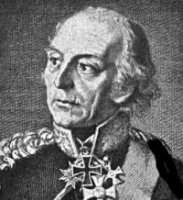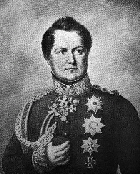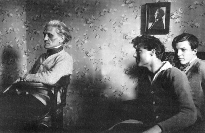![]()
Chapters
References
Early Life and Influences
 Field Marshall Peter Yorck von Wartenburg  Field Marshall August von Gneisenau  The poet Stefan George (far left) with Claus (center) and Berthold (far right) von Stauffenberg, November, 1924 |
Claus Phillip Maria Schenk von Stauffenberg was born on November 15, 1907 in Bavaria to a family which had long been associated with the old Swabian nobility. At a young age Claus had come to the conclusion that, as an aristocrat, it was his responsibility to defend the nation, keep true its laws, and defend it from abominations of justice and despotism. Much of this youthful inspiration seems to have come from two maternal ancestors, Field Marshall Count Peter Yorck von Wartenburg and Field Marshall Count August von Gneisenau, who had both helped to rid Prussia of Napoleon during the Napoleonic Wars. Stauffenberg admired the way leaders like Yorck and Gneisenau could become “politically engaged”, that is, they could transcend the limitations demanded by their chosen professions and see things from a not so black and white perspective. “Not only had they acted as instruments of popular will. They had also tempered, contained, curbed and channeled the potentially anarchic energy that will had unleashed. As always with Stauffenberg, the sense of aristocratic responsibility functioned as a governing principle, a moral imperative. It went hand in hand with a respect for the people, but a mistrust of the mob. As he stated on another occasion: ‘Popular guidance is an inescapable and important part of politics, and is not something to be left to any Tom, Dick, or Harry without disastrous consequences."[1] As Claus matured his parents realized that he, as well as his brothers Berthold and Alexander, needed to be mentored in art and the humanities by someone other than their local gymnasium (high school) because the scope of education there was limited. To that end, in 1923 they sought help from the German poet Stefan George. George detested the bourgeois mentality, moral constraints and pre-Vatican two church rites that made up 1920’s Germany. He wished to create a newer, nobler standard of values. “George strove to teach his friends a sense of form acquired in and through poetry and regarded as a mental discipline and guide to relationships with others. At a time when spiritual, social, political, and artistic standards were collapsing, George offered “form” as an ideal, maintaining that poetry was the air which the intellectual movement in Germany must breathe if it was to live."[2] George’s
poetry and way of thinking was also noticed by a small but
growing political party based in Bavaria. Known as the National
Socialist German Workers Party or Nazi Party for short, they
would inevitably lay claim to some George’s symbols and
expressions. The notion of “the thousand year Reich” and “fire
of the blood” are two concepts that were used for Nazi
propaganda. George would come to detest the policies and racial
theories of the National Socialist movement, especially the
racial theory of the Nordic “superman.” “All of this chatter
about supermen,” he said, “will merely act as a challenge to the
oppressed to rise. Is it not better quietly to ensure that man
is capable of meeting the highest demands which can be made upon
him? A racial policy is no new thing; it is an evil legacy from
the nineteenth century. Only the spirit, not some breeding
establishment, is capable of producing a good new race of
men."[3] George was a man of action, a trait which fit
perfectly into Stauffenberg’s character. The philosophy of
Stefan George would prove to exert a very powerful influence
over Stauffenberg during his formative years and would linger
with him until his dying day.
Home
Early Life
and Influences Continued Site designed and maintained by Bill Jeffers
Public History at the University of North
Carolina at Charlotte
|
